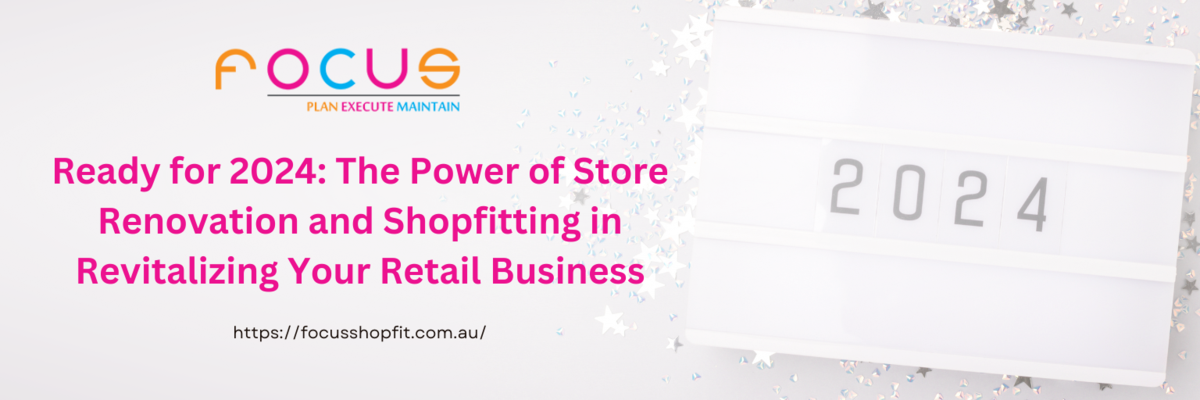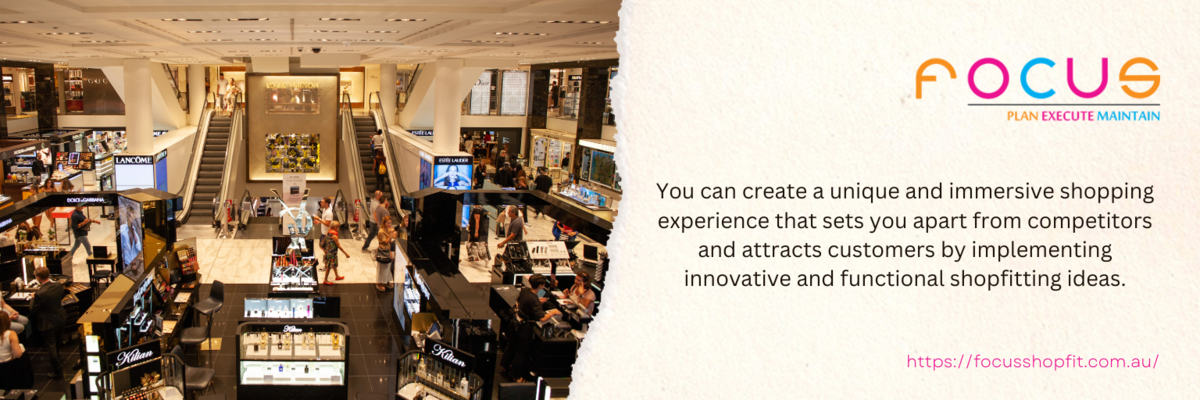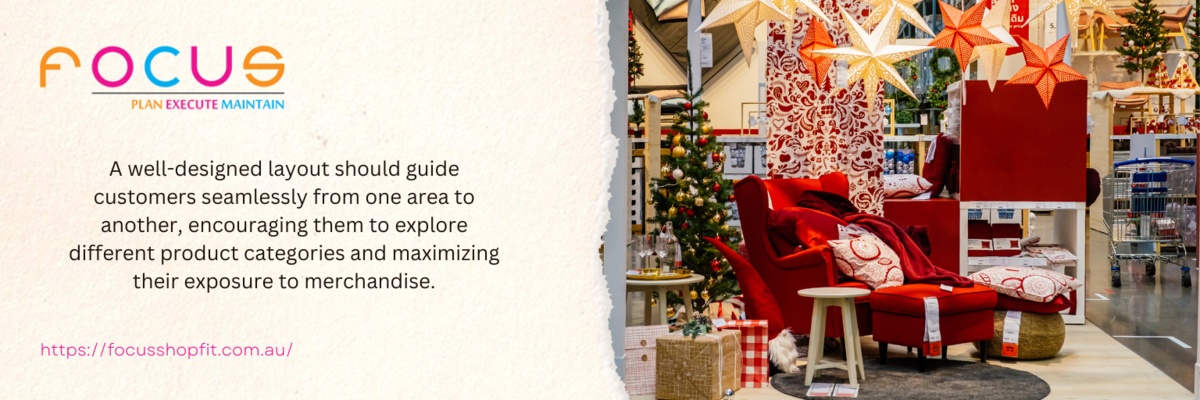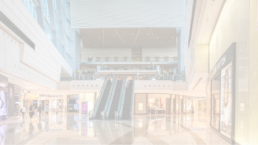Stay Ahead of the Curve: Top Shopfitting Trends to Watch in 2024
As the retail industry continues to evolve, shopfitting plays a crucial role in creating inviting and immersive spaces for customers. To stay ahead of the curve and remain competitive in the ever-changing landscape, retailers need to be aware of the latest trends in shopfitting. In this article, we will explore the top shopfitting trends to watch in 2024, from sustainable solutions to the integration of technology and the rise of personalized experiences. By embracing these trends, retailers can create unique and memorable retail environments that captivate their customers.

- Sustainable Shopfitting Solutions
In 2024, sustainability will be at the forefront of shopfitting trends. Consumers are becoming increasingly conscious of their environmental impact, and they expect retailers to do the same. Retailers can incorporate sustainable practices into their shopfitting designs by opting for eco-friendly materials, such as reclaimed wood or recycled plastics. Additionally, energy-efficient lighting solutions and smart HVAC systems can help reduce the store's carbon footprint. By embracing sustainability in their shopfitting choices, retailers not only contribute to a greener future but also attract environmentally-conscious customers.
Furthermore, retailers can explore innovative ideas such as incorporating living walls or vertical gardens into their shopfitting designs. These green features not only add aesthetic appeal but also improve air quality and create a calming atmosphere. Investing in renewable energy sources, such as solar panels, can also be a step towards achieving sustainability goals in shopfitting. By adopting sustainable shopfitting solutions, retailers can align their brands with the growing demand for eco-friendly practices and create a positive impact on the environment.
- Technology in Shopfitting
In the digital age, technology plays a crucial role in enhancing the customer experience. In 2024, we can expect to see a rise in the integration of technology in shopfitting. From interactive displays to smart mirrors and self-checkout systems, technology will create a seamless and personalized shopping experience for customers. For instance, augmented reality (AR) and virtual reality (VR) can be utilized to allow customers to visualize products in their own space or try on virtual outfits. This technology not only saves time but also enhances customer engagement and satisfaction.
Moreover, the use of smart shelves and RFID tags can provide real-time inventory updates, ensuring that products are always available to customers. Retailers can also utilize data analytics to gain valuable insights into customer behavior and preferences, allowing them to tailor their shopfitting designs and product offerings accordingly. By embracing technology in shopfitting, retailers can create a modern and efficient shopping environment that meets the expectations of tech-savvy customers.
- Multi-functional and Flexible Shopfitting Designs
In 2024, shopfitting designs will focus on maximizing space and flexibility. Retailers need to adapt to changing consumer needs and create versatile environments that can be easily transformed. This can be achieved through the use of modular fixtures and movable walls that can be adjusted to accommodate different product displays or events. By creating flexible spaces, retailers can easily refresh their store layouts and adapt to seasonal trends or new product launches.
Additionally, multi-functional shopfitting designs that serve dual purposes will gain popularity. For example, a display table that doubles as a charging station for customers' electronic devices or seating areas that can be transformed into pop-up shops. These innovative designs not only optimize space but also provide added convenience and value to customers. By embracing multi-functional and flexible shopfitting designs, retailers can create dynamic and adaptable spaces that cater to the ever-changing retail landscape.

- Integration of Online and Offline Shopping Experiences
With the rise of e-commerce, the integration of online and offline shopping experiences has become essential for retailers. In 2024, we can expect to see more seamless integration between physical stores and digital platforms. Retailers can incorporate interactive touch screens or kiosks where customers can browse and purchase products that may not be available in-store. This integration allows customers to enjoy the convenience of online shopping while still benefiting from the tactile experience of a physical store.
Additionally, click-and-collect services will become more prevalent, allowing customers to order online and pick up in-store. This not only drives foot traffic to brick-and-mortar locations but also provides an opportunity for retailers to upsell and cross-sell products. Integration of online and offline shopping experiences also opens up possibilities for personalized recommendations and targeted marketing campaigns based on customer data. By embracing this trend, retailers can create a seamless and cohesive shopping experience that bridges the gap between their online and offline presence.
- Personalization and Customization in Shopfitting
In 2024, personalization and customization will continue to be important factors in shopfitting. Customers crave unique experiences and products that reflect their individuality. Retailers can cater to this demand by offering personalized shopping experiences through the use of technology and data analysis. For example, interactive displays can recommend products based on customers' preferences or previous purchases, creating a tailored shopping experience.
Moreover, customization options will become more prevalent, allowing customers to personalize products or choose from a variety of options. This can include customizing the color, material, or features of a product. By offering customization, retailers not only meet customers' desire for uniqueness but also create a sense of ownership and connection to the brand. Personalization and customization in shopfitting allow retailers to differentiate themselves from the competition and create a loyal customer base.
- Creating Immersive and Experiential Retail Spaces
In 2024, creating immersive and experiential retail spaces will continue to be a top trend in shopfitting. Customers seek memorable and engaging experiences that go beyond traditional shopping. Retailers can create immersive environments by incorporating elements such as sound, lighting, and interactive displays. For example, a clothing store can utilize ambient lighting and curated playlists to create a unique atmosphere that reflects the brand's identity.
Furthermore, pop-up shops and temporary installations will gain popularity, providing customers with limited-time experiences and exclusive products. Retailers can also host events or workshops within their stores to engage with customers and build a sense of community. By creating immersive and experiential retail spaces, retailers can create a lasting impression on customers, drive foot traffic, and encourage social sharing, ultimately increasing brand awareness and loyalty.
Embracing the Future of Shopfitting
Staying ahead of the curve in shopfitting is crucial for retailers to thrive in the ever-evolving retail industry. By embracing sustainable solutions, integrating technology, creating multi-functional designs, bridging the gap between online and offline experiences, offering personalization and customization, and creating immersive retail spaces, retailers can create unique and captivating environments that resonate with customers.

As we look towards 2024, it's clear that shopfitting will continue to play a vital role in shaping the retail landscape. By keeping a pulse on the latest trends and incorporating them into their shopfitting strategies, retailers can stay ahead of the curve and provide exceptional shopping experiences for their customers.
Ready for 2024: The Power of Store Renovation and Shopfitting in Revitalizing Your Retail Business
In the fast-paced world of retail, staying relevant and enticing customers is crucial for success. One way to achieve this is through store renovation. Store renovation is not only about giving your store a fresh look, but it also has the power to revitalize your retail business in multiple ways.

Store renovation can improve the overall customer experience. Outdated and worn-out stores can leave customers with a negative impression, making them less likely to return or recommend your business to others. By investing in store renovation, you can create a visually appealing and inviting space that attracts customers and encourages them to spend more time exploring your products.
Renovation can enhance your brand image. A well-designed store that aligns with your brand identity can communicate your values and unique selling propositions effectively. It can help establish a positive perception of your business in the minds of your customers, making them more likely to trust your products and services.
Furthermore, a store makeover can optimize your store layout for better functionality. As consumer behaviors and preferences evolve, it's important to adapt your store's layout to accommodate these changes. By re-evaluating the flow of your store, you can optimize product placement, create designated areas for different product categories, and improve navigation for customers. This can lead to increased sales and improved customer satisfaction.
Benefits of Store Renovation
Store renovation offers numerous benefits for retail businesses. Apart from the improvements in customer experience, brand image, and store layout, there are other advantages worth considering.
One significant benefit is increased foot traffic. A newly renovated store often attracts curious customers who want to see the changes and experience the improved environment. This surge in foot traffic can translate into higher sales and increased brand visibility, especially if you promote your store renovation through marketing efforts.
Store renovation also provides an opportunity to incorporate new technologies. As the retail industry becomes more digitized, integrating technology into your store can enhance the shopping experience and streamline operations. For example, interactive displays, self-checkout systems, and personalized digital signage can all be implemented during a store renovation to create a seamless and modern shopping environment.
Additionally, store renovation can boost employee morale and productivity. A well-designed and updated store can create a more positive and inspiring work environment for your staff. This can lead to increased job satisfaction, improved customer service, and ultimately, better business performance.
Store Renovation Statistics
The impact of store renovation on retail businesses is supported by various statistics. According to a study conducted by the National Retail Federation, 42% of consumers are more likely to shop at a store that has been recently renovated or updated. Additionally, the Retail Design Institute found that store renovations can result in a 25% increase in sales. These statistics highlight the significance of store renovation in attracting customers and driving revenue.
Furthermore, a survey conducted by Retail TouchPoints revealed that 77% of retailers believe that store renovation positively impacts brand perception, while 71% stated that it improves customer satisfaction. These findings emphasize the importance of store renovation in creating a positive brand image and enhancing the overall shopping experience.

Assessing the Need for Store Renovation
Before embarking on a store renovation project, it's important to assess the need for renovation and identify areas that require improvement. One way to do this is by conducting a thorough evaluation of your current store. Look for signs of wear and tear, outdated fixtures, and any elements that may hinder the customer experience.
Additionally, gather feedback from your customers. Conduct surveys or engage in conversations to understand their perceptions of your store. Identify areas where they feel improvements are needed, such as lighting, layout, or product displays. This feedback can provide valuable insights into the specific areas that should be addressed during the renovation process.
Furthermore, analyze your sales data and compare it to industry benchmarks. If you notice a decline in sales or struggle to meet your targets, it may be an indication that your store needs a refresh. A well-executed store renovation can help attract new customers, re-engage existing ones, and ultimately drive sales.
Planning Your Store Renovation
Planning is a crucial step in ensuring a successful store renovation. Start by setting clear goals and objectives for the project. Determine what you want to achieve through the renovation, whether it's improving the store's aesthetics, enhancing functionality, or aligning with a rebranding strategy.
Next, create a detailed timeline and budget for the renovation. Set realistic deadlines and allocate resources accordingly. Consider factors such as permits, construction time, and potential disruptions to your business operations. It's important to plan for contingencies and allow for flexibility in case unexpected issues arise.
During the planning phase, also consider the impact of the renovation on your customers. Communicate the upcoming changes to your loyal customers through various channels, such as email newsletters, social media, and in-store signage. Provide them with information about the benefits they can expect from the renovation and any temporary inconveniences they may experience.
Hiring a Shopfitting Company
To ensure a successful store renovation, it's advisable to hire a professional shopfitting company. Shopfitting companies specialize in designing and renovating retail spaces, and they have the expertise and experience to transform your store into a captivating and functional environment.
When selecting a shopfitting company, consider its reputation, portfolio, and track record. Look for companies that have worked on similar projects in the past and have a proven record of delivering high-quality results. Request references and testimonials from their previous clients to gain insights into their level of professionalism and customer satisfaction.
Collaborate closely with the shopfitting company throughout the renovation process. Communicate your goals and expectations, and provide them with any specific requirements or design preferences. Regularly review their progress and provide feedback to ensure that the renovation aligns with your vision.
Budgeting for Store Makeover
Store renovation can be a significant investment, so it's important to budget wisely. Start by assessing your available funds and determining how much you can allocate to the renovation project. Consider factors such as construction costs, shopfitting fees, permits, and any additional expenses, such as new fixtures or equipment.
It's also essential to factor in potential return on investment (ROI). While store renovation can be costly upfront, it can lead to increased sales and customer loyalty in the long run. Analyze your sales data and projections to estimate the potential ROI and determine the maximum budget you can allocate without negatively impacting your business's financial stability.
To optimize your budget, prioritize the areas that will have the greatest impact on your store's overall appeal and functionality. Focus on essential renovations first, such as improving lighting, enhancing store layout, or replacing worn-out fixtures. You can always allocate a portion of your budget to aesthetic upgrades or additional features once the essential renovations are complete.

Revitalizing your Business
Store renovation is a powerful tool for revitalizing your retail business. By improving the customer experience, enhancing your brand image, and optimizing your store layout, you can attract more customers, increase sales, and stay ahead of the competition.
When planning a store renovation, carefully assess the need for renovation, set clear goals, and create a detailed budget and timeline. Consider hiring a professional shopfitting company to ensure a successful outcome. Stay updated with the latest store renovation trends and ideas to create a truly captivating and modern shopping environment.
Remember to prioritize functionality, avoid common renovation mistakes, and maintain brand consistency throughout the process. By investing in store renovation, you can transform your outdated store into a dazzling space that captivates customers and brings new life to your retail business.
New Year, New Shopfitting Ideas for your Store
Shopfitting is the process of designing and fitting out retail stores to create an attractive and functional space for customers. It involves everything from the layout and design of the store to the installation of fixtures and fittings. Shopfitting plays a crucial role in the success of a retail business as it directly impacts the customer's experience and perception of the brand. By carefully planning and implementing shopfitting ideas, store owners can create a unique and inviting environment that sets them apart from the competition.

Stay ahead of the competition with these trendy shopfitting ideas for your store
In today's highly competitive retail industry, staying ahead of the competition is essential for the success of any business. With consumers having more options than ever before, retailers must find ways to differentiate themselves and attract customers. One way to do this is through innovative shopfitting ideas. By incorporating the latest trends and technologies into their store design, retailers can create a shopping experience that is both memorable and immersive, leaving a lasting impression on their customers.
Shopfitting trends for the new year
As the new year approaches, it's time for retailers to start thinking about how they can update their store designs to stay ahead of the competition. Here are some trendy shopfitting ideas to consider:
- Incorporating technology into your shopfitting design
Technology has become an integral part of our lives, and it's no different when it comes to retail. Incorporating technology into your shopfitting design can enhance the customer's shopping experience and make it more interactive and engaging. For example, you could install digital signage displays that showcase your products and promotions in a dynamic and eye-catching way. You could also consider implementing virtual reality or augmented reality experiences to allow customers to try on clothing or visualize how furniture would look in their homes virtually.
- Creating a memorable and immersive shopping experience
In today's fast-paced world, consumers are looking for more than just a place to buy products. They want an experience. Creating a memorable and immersive shopping experience can help you stand out from the competition and attract loyal customers. Consider incorporating elements such as sensory branding, where you use scents, sounds, and textures to create a unique atmosphere in your store. You could also create interactive product displays or offer personalized shopping experiences to make your customers feel special and valued.
- Utilizing sustainable and eco-friendly shopfitting materials
With increasing awareness about environmental issues, consumers are becoming more conscious of their purchasing decisions. By utilizing sustainable and eco-friendly shopfitting materials, you can appeal to this growing market segment and differentiate yourself from competitors. Consider using materials such as reclaimed wood, recycled plastic, or eco-friendly lighting options. Not only will this help reduce your store's carbon footprint, but it will also show your customers that you care about the environment.

The impact of visual merchandising in shopfitting
Visual merchandising is a critical component of shopfitting that focuses on how products are displayed and presented in-store. It involves arranging products in an aesthetically pleasing and strategic way to attract customers and encourage them to make a purchase. The way you present your products can greatly impact your store's sales and overall success. Consider using eye-catching displays, strategic lighting, and creative signage to draw attention to your products and create a visually appealing shopping environment.
Collaborating with shopfitting professionals for innovative ideas
While it's possible to come up with shopfitting ideas on your own, collaborating with shopfitting professionals can help bring your vision to life and ensure that your store design is both functional and aesthetically pleasing. Shopfitting professionals have the expertise and experience to guide you through the design process, offer innovative ideas, and help you make informed decisions. By working with professionals, you can save time and avoid costly mistakes, ultimately leading to a more successful and profitable store.

Implementing trendy shopfitting ideas for a successful retail store in the new year
In the ever-evolving retail industry, staying ahead of the competition is crucial for the success of your store. By implementing trendy shopfitting ideas, you can create a unique and immersive shopping experience that sets you apart from competitors and attracts customers. From incorporating technology to utilizing sustainable materials and focusing on visual merchandising, there are countless ways to enhance your store design and stay ahead in the new year. Remember to collaborate with shopfitting professionals for innovative ideas and look to successful case studies for inspiration. By staying ahead of the competition, you can ensure the success and growth of your retail business in the new year and beyond.
Planning Store Renovation and Shopfitting for the New Year
Store renovation and shopfitting are crucial aspects of keeping a retail business fresh, appealing, and competitive. As the new year approaches, it is the perfect time to assess your store's current condition and plan for necessary changes and improvements. Store renovation involves updating the physical space, while shopfitting focuses on ensuring that the store layout, fixtures, and displays are optimized for customer experience and sales. By investing time and resources into planning store renovation and shopfitting, businesses can create a welcoming and attractive environment that drives customer engagement and boosts sales.

First and foremost, store renovation and shopfitting help businesses stay relevant in an ever-evolving market. Consumer preferences, trends, and technology are constantly changing, and retailers need to adapt accordingly. Outdated store layouts, worn-out fixtures, and uninspiring designs can lead to a decline in foot traffic and sales. By planning store renovation and shopfitting, businesses can revitalize their image, attract new customers, and retain existing ones. A fresh and modern store design can create a positive impression, enhance the overall shopping experience, and differentiate the business from competitors.
Additionally, store renovation and shopfitting offer opportunities to optimize the use of space and improve operational efficiency. Over time, a store's layout may become inefficient, hindering staff productivity and customer flow. By reevaluating the store's layout during the planning phase, businesses can identify bottlenecks, eliminate wasted space, and create a more streamlined and organized environment. This can lead to improved customer service, easier navigation for shoppers, and better utilization of available square footage.
Benefits of Planning Store Renovation
Proper planning is the cornerstone of a successful store renovation and shopfitting project. By taking the time to carefully consider all aspects of the project, businesses can reap numerous benefits. One of the key advantages of planning is cost control. Without a well-thought-out plan, store renovation and shopfitting projects can easily exceed budgetary constraints. By thoroughly assessing the scope of work, creating a detailed budget, and obtaining multiple quotes from contractors and suppliers, businesses can ensure that the project remains within financial limits. Planning also allows businesses to prioritize renovation tasks based on urgency and available resources, preventing unnecessary expenses and delays.
Another benefit of planning is the ability to minimize disruption to daily operations. Store renovation and shopfitting can be disruptive to both staff and customers, potentially leading to a temporary decrease in sales. By carefully scheduling the project and coordinating with contractors, businesses can mitigate the impact on day-to-day operations. For example, certain renovation tasks can be carried out during off-peak hours or temporary store closures. By planning the project timeline strategically, businesses can minimize inconvenience and maintain customer satisfaction.
Factors to Consider Before Starting a Store Renovation Project
Before embarking on a store renovation and shopfitting project, it is essential to consider several factors that can significantly impact the outcome and success of the project. First and foremost, businesses should have a clear understanding of their goals and objectives for the renovation. Are they aiming to increase foot traffic, improve customer experience, or enhance brand image? By defining these objectives beforehand, businesses can align their renovation plans accordingly and make informed decisions throughout the project.
Budget is another critical factor to consider. Renovation projects can vary widely in cost, depending on the scale and complexity of the changes. It is essential to establish a realistic budget and allocate funds for different aspects of the renovation, including construction, fixtures, materials, and professional services. By accurately estimating costs and setting a budget, businesses can avoid overspending or compromising the quality of the renovation.
Additionally, businesses should consider the impact of the renovation on their staff and customers. Will the store need to be temporarily closed? How will the renovation affect employee schedules and workspaces? By anticipating these potential disruptions and communicating with staff and customers in advance, businesses can minimize inconvenience and maintain a positive relationship with their stakeholders.
Creating a Budget for Store Renovation and Shopfitting
Creating a budget is a crucial step in the planning process for store renovation and shopfitting. A well-defined budget helps businesses allocate resources effectively, prioritize tasks, and control costs throughout the project.
To create a budget, businesses should start by conducting thorough research on the estimated costs of various renovation elements. This includes construction, fixtures, materials, permits, and professional services. It is essential to obtain multiple quotes from contractors and suppliers to ensure accurate pricing information.
Next, businesses should consider any additional expenses that may arise during the renovation process. These can include unexpected repairs, change orders, or modifications to the original plan. By setting aside a contingency fund, businesses can protect themselves from unforeseen costs and keep the project on track.
Once all the costs have been identified, businesses should allocate specific amounts to each aspect of the renovation. This includes categorizing expenses such as demolition, electrical work, plumbing, flooring, painting, fixtures, and professional fees. By breaking down the budget into detailed categories, businesses can better track expenses, identify areas where cost savings can be made, and make informed decisions throughout the project.
It is crucial to regularly review and update the budget as the renovation progresses. Unexpected expenses may arise, and adjustments may need to be made along the way. By closely monitoring the budget and comparing actual costs against the estimated amounts, businesses can ensure that the project remains within financial constraints.
Hiring Professionals for Store Renovation and Shopfitting
Store renovation and shopfitting projects often require the expertise of professionals to ensure a successful outcome. Hiring professionals can save time, minimize costly mistakes, and ensure their project meets all relevant regulations and standards.
One of the key professionals to consider is an architect or interior designer. These professionals have the knowledge and experience to create a functional and visually appealing store layout. They can analyze the store space, understand customer flow, and design a layout that optimizes sales and enhances the overall shopping experience. An architect or interior designer can also provide valuable insights on the selection of materials, fixtures, and finishes that align with the store's brand image and target market.
Contractors and construction professionals are essential for executing the physical aspects of the renovation. They have the skills and expertise to carry out tasks like demolition, carpentry, electrical work, plumbing, and painting. Hiring licensed and reputable contractors ensures the renovation is done safely, adhering to all building codes and regulations. It is important to obtain multiple quotes and thoroughly vet potential contractors to ensure a high level of quality and professionalism.
In addition to architects and contractors, businesses may also need the services of specialized professionals, such as lighting designers, signage experts, and audiovisual technicians. These professionals can help create a cohesive and engaging store environment that enhances the customer experience and effectively showcases products.

Store Layout and Design Considerations
The layout and design of a store play a significant role in attracting customers, encouraging exploration, and influencing purchasing decisions. When planning store renovation and shopfitting, businesses should carefully consider various layout and design elements to create an inviting and functional space.
One important consideration is the flow of customer traffic within the store. A well-designed layout should guide customers seamlessly from one area to another, encouraging them to explore different product categories and maximizing their exposure to merchandise. The layout should also consider factors such as customer behavior, natural pathways, and the positioning of high-margin products or promotional displays.
Another crucial aspect is creating focal points and visual merchandising displays that capture customers' attention. Focal points can be created through the strategic placement of eye-catching fixtures, displays, or product showcases. These focal points should be positioned in areas of high customer traffic and should reflect the store's brand image and desired atmosphere. Visual merchandising displays should be regularly refreshed to maintain customer interest and highlight new products or promotions.
Lighting is another vital consideration in store layout and design. Adequate lighting can enhance the visibility and appeal of merchandise, create a welcoming ambiance, and guide customers through different areas of the store. A combination of general lighting, accent lighting, and task lighting should be used to create a balanced and visually appealing environment.
Businesses should consider the store's overall aesthetic and branding. The design elements, color scheme, and signage should align with the store's target market and brand identity. Consistency in design across all areas of the store creates a cohesive and memorable experience for customers.
Selecting the Right Materials and Fixtures for Shopfitting
Choosing the right materials and fixtures is crucial in achieving an attractive and functional store environment. During the planning phase of store renovation and shopfitting, businesses should carefully consider the following factors when selecting materials and fixtures.
Durability is a key consideration, especially for high-traffic areas or areas prone to wear and tear. Materials such as commercial-grade flooring, durable wall finishes, and scratch-resistant fixtures should be chosen to ensure longevity and minimize maintenance costs. Fixtures should also be sturdy and able to withstand frequent use and handling.
Aesthetics and brand identity should also guide the selection of materials and fixtures. The chosen materials should reflect the desired store atmosphere and brand image. For example, a high-end boutique may opt for luxurious materials such as marble or hardwood, while a casual clothing store may choose more affordable and contemporary materials.
Sustainability is an increasingly important consideration for many businesses. By opting for eco-friendly materials and fixtures, businesses can demonstrate their commitment to environmental responsibility and appeal to environmentally conscious customers. Sustainable options include recycled materials, low-VOC paints, energy-efficient lighting, and fixtures made from renewable resources.
Functionality is another critical factor to consider. Fixtures and materials should be chosen based on their intended purpose and the specific needs of the store. For example, clothing racks should be designed to accommodate different types of garments and maximize display space. Shelving units and storage solutions should be selected to optimize organization and accessibility.
Lastly, cost is an important consideration, especially for businesses with limited budgets. While it is essential to prioritize quality and durability, businesses should also seek cost-effective options that offer good value for money. Comparing prices, obtaining multiple quotes, and considering the long-term maintenance costs of materials and fixtures can help businesses make informed decisions and stay within budget.
Timeline and Project Management for Store Renovation
A well-defined timeline and effective project management are essential for the successful execution of store renovation and shopfitting projects. By carefully planning and coordinating all tasks, businesses can ensure that the project stays on schedule and minimize disruption to operations.
The first step in creating a timeline is to identify the key milestones and deadlines for the project. This includes determining the start and end dates, as well as any interim deadlines for specific tasks or phases. Businesses should consider factors such as the availability of contractors, delivery times for materials, and any time-sensitive events or promotions.
Once the milestones and deadlines are established, businesses should create a detailed project schedule. This schedule should outline all tasks, their dependencies, and the estimated duration for each task. It is important to consider potential delays or unexpected challenges that may arise during the renovation process. By building in buffer time, businesses can mitigate the impact of these unforeseen circumstances and maintain the project timeline.
Effective project management involves coordinating and communicating with all stakeholders involved in the renovation. This includes architects, contractors, suppliers, and staff members. Regular meetings should be scheduled to review progress, discuss any issues or concerns, and make necessary adjustments to the plan. Clear lines of communication should be established, and responsibilities and expectations should be clearly defined for all parties involved.
Throughout the project, it is crucial to monitor progress against the timeline and make adjustments as needed. Delays or unexpected challenges should be addressed promptly to prevent further disruptions. By staying proactive and maintaining open lines of communication, businesses can ensure that the renovation project stays on track and is completed within the established timeline.
Tips for a Successful Store Renovation and Shopfitting Process
Store renovation and shopfitting projects can be complex and challenging, but with careful planning and execution, businesses can achieve a successful outcome. Here are some tips to ensure a smooth and efficient renovation process:
Start with a clear vision: Define your goals and objectives for the renovation and communicate them to all stakeholders. This will guide decision-making and ensure alignment throughout the project.
Assemble a strong team: Hire experienced professionals who specialize in store renovation and shopfitting. Their expertise will help navigate challenges and ensure a high-quality outcome.
Communicate with stakeholders: Keep staff, customers, and suppliers informed about the renovation plans and any disruptions that may occur. Maintain open lines of communication to discuss and resolve any concerns or questions.
Plan for contingencies: Set aside a contingency fund and build buffer time into the project timeline to account for unexpected delays or challenges.
Regularly review progress: Monitor the project against the timeline and budget, and make adjustments as needed. Regularly communicate with the project team to address any issues or concerns.
Consider customer experience: Keep the needs and preferences of your target customers in mind when making design and layout decisions. Focus on creating a welcoming and engaging environment that enhances the shopping experience.
Prioritize safety: Ensure that all renovation work is carried out safely and in compliance with building codes and regulations. Regularly inspect the work site and address any safety concerns promptly.
Maintain a clean and organized work environment: A clean and organized work site promotes efficiency and professionalism. Regularly clean up debris, organize tools and materials, and ensure that the work site is safe and accessible.
Plan for reopening: Develop a marketing and promotional plan to generate excitement and drive foot traffic when the store reopens. Consider hosting a grand reopening event or offering special discounts to attract customers.
Evaluate and learn from the experience: Once the renovation is complete, evaluate the results and gather feedback from staff and customers. Identify areas for improvement and apply these lessons to future renovation projects.
By following these tips and investing in careful planning and execution, businesses can ensure a successful store renovation and shopfitting process that leads to a more attractive and profitable retail environment.

Store Renovation and Shopfitting for Business Success
Store renovation and shopfitting are essential for businesses to stay competitive in a rapidly changing retail landscape. By investing in store renovation and shopfitting, businesses can revitalize their image, attract new customers, and improve operational efficiency. A well-planned renovation project can enhance the overall shopping experience, drive customer engagement, and ultimately increase sales. Through careful planning, communication, and execution, businesses can create a welcoming and attractive store environment.

